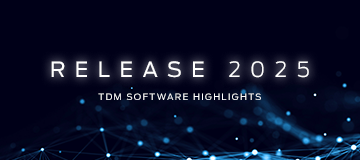Oskar, you are head of the newly formed Tool Flow Solutions (TFS) division.
That sounds like a lot of work. What is your day-to-day work like at the moment?
Oskar: For the most part, I am currently balancing strategic and operational responsibilities, working on both short-term issues and long-term goals. I work closely with our customers and partners to get a feel for their experience of working with us and their needs. Our main goal is to improve their work and experience with us as a partner. And then of course there's a lot of internal coordination, mostly finding a common workflow and onboarding new team members as we continue to grow our team.
One year ago, the Sandvik Group established a new division, Tool Flow Solutions.
What are the goals for TFS?
Oskar: We want to be a leader in the digitalization of manufacturing. More specifically, we want to provide seamless and integrated solutions that help organize tool management processes to become more productive and sustainable.
As President of a new division, you can set the course from the very beginning,
what is your personal focus at the moment?
Oskar: The most important thing for me is to focus on innovation and investing in new technologies and solutions. Our customers move fast, and our job is to stay one step ahead of them so that they can always take the next step. The area where I see the most potential right now is in data services. Let me give you an example. We want to go from an onboarding process that takes months to one that takes minutes. We're already doing a lot of work with AI and machine learning to make the customer experience more seamless.
That sounds like a lot going on right now, are there any changes or disruptions
your customers should be aware of?
Oskar: While a lot has changed on the surface, I can assure our customers that there is nothing to worry about from their perspective. In fact, by combining the forces of TDM Systems and CRIBWISE, we have a bigger team and better services for all customers and can provide services that are even more tailored to their specific needs.
TFS is part of a larger digitalization strategy at Sandvik. Can you give some insight
into the whole project?
Oskar: On the highest level the Sandvik strategy is focused on creating smart, connected solutions that allow our customers to automate their manufacturing processes from end to end. By doing that we hope to help the whole manufacturing industry to become more efficient and sustainable. We have a long history and a lot of expertise in cutting tools and machining. One of our goals is to combine these capabilities with software tools and digital businesses that we have acquired and built over the last years. Stitching it all together, so to speak. As a Sandvik customer you should be able to use one of our solutions and then move to another seamlessly.
What specific role does TFS play in this overall strategy?
Oskar: Tool Flow Solutions holds a key position within the whole strategy, because our TFS solutions are used everywhere in the manufacturing chain: Tool data is needed for planning and preparation, on the shop floor and for logistic processes and finally also for the actual execution of the machining.
To conclude, what is particularly important to you when you think about the future goals of TFS?
Oskar: We are really shifting gears in innovation and technological development. I already talked about the importance of Data Services but another example is the concept of interoperability. We are working on concepts right now that will make it much easier to integrate our solutions and our software in other shop floor systems. Our main goal is to make the user experience more intuitive, easier, quicker and suitable for a new generation of users that are used to work with modern and intuitive interfaces. And finally, the cloud space is also a very important topic for us. We want to be infrastructure agnostic. That means that we have a solution for every customer, no matter if they want to operate on the premise, in a private cloud that they are running themselves or if they want us to operate the cloud environment. In short: we want to be able to work with any kind of customer and cater their needs.


